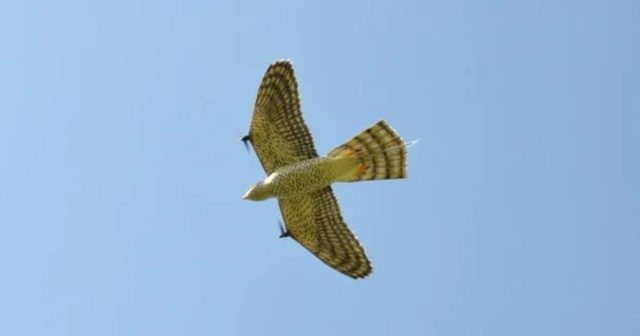09
Nov
“RobotFalcon” Takes to the Skies to Replace Pesticides and Lethal Tactics to Deter Birds at Airports

(Beyond Pesticides, November 9, 2022) A team of Dutch researchers has developed an artificial predator dubbed the RobotFalcon that can quickly and successfully scare bird flocks away from fields, providing a new practical, ethical tool to deter bird strikes near airports. Although it sounds like a conspiracy theory, in the skies above Workum, The Netherlands, for a period of time, some of the birds were not real. Current data indicate there are over 17,000 wildlife strikes to aircraft each year in the U.S., costing an estimated $500 million in economic losses, yet these problems are ongoing despite the U.S. Department of Agriculture’s Wildlife Services program killing hundreds of thousands of birds in and around airports each year through a range of lethal means, including the use of guns and pesticides. As a result, new management approaches that focus on effective, nonlethal alternatives to the use of toxic chemicals are urgently needed.
Scientists began their research with the understanding that most bird deterrent methods “suffer from some degree of habituation: after repeated exposure, birds respond less.” While habitation can be reduced through natural threats, the authors note that approaches like falconry are lethal and can be prohibitively expensive and difficult to maintain. The RobotFalcon, attempts to solve this limitation. A fiberglass drone built to resemble the shape of a peregrine falcon, the RobobotFalcon can be steered to focus on a particular flock of birds in attempts to drive them away from a given area.
Efficacy tests were conducted in Workum, NL, in an agricultural area, and focused on deterring species of corvids, gulls, and starlings – birds that are frequently involved in aircraft strikes. The deterrence capacity of the RobotFalcon was compared to a regular drone and the tactics used at a nearby airbase, which included pyrotechnics (fireworks) and distress calls. Trials began once target birds landed in the field and were measured primarily based on how quickly, and how long the approach cleared birds out of the field area.
In a direct comparison between the RobotFalcon and the drone, the RobotFalcon cleared more flocks quicker, and was more effective at keeping flocks of fleeing birds airborne, rather than occasionally landing as was seen with the drone. Efficacy in this matter increased further when the RobotFalcon fly at a higher altitude.
The RobotFalcon kept flocks of starlings out of the area for a median time of four hours, compared to distress calls and fireworks, which were effective for 1.83 and 1.1 hours respectively. Gulls were deterred for three hours by the RobotFalcon, but only half that time when researchers used distress calls. However, all approaches kept corvids away for roughly one hour.
Critically, birds did not get used to the RobotFalcon flying in the skies. “In our three months of fieldwork, there was no evidence of habituation of birds to the RobotFalcon,” the study’s authors wrote. “We speculate that the RobotFalcon continued to be effective because of its resemblance in behavior and appearance to a real falcon.”
The device has some drawbacks however, requiring training and good weather conditions, and can currently only fly for approximately 15 minutes at a time.
The results of the study find RobotFalcon as a viable alternative to the use of toxic pesticides to haze, deter, or kill bird flocks near airports. One frequently used pesticide is the product Avitrol, containing the chemical 4-Aminopyridine. The product is generally fed to birds through treated corn. The chemical is highly toxic to mammals, harming the nervous system and resulting in potential death through heart failure. Avitrol has a significant risk of killing nontarget birds and other organisms that may eat the disbursed grain. Birds that do experience seizure-like symptoms, but the manufacturer claims that affected animals “are not in pain.” In 2014, Houston’s Bush International Airport utilized the chemical and shocked airport employees as they watched hundreds of birds succumb to the poison. Animal rights groups have strongly criticized the practice, with Humane Society of the US senior scientist John Hadidian, PhD noting, “These deaths look anything but humane… The birds that are dying after ingesting this compound are suffering and in great distress.” At the time, an airport employee posted a video of what they experienced.
Help support efforts to protect migrating from toxic pesticides and other threats by urging your Senator to cosponsor S4187, the Neotropical Migratory Bird Conservation Enhancements Act. And to learn more about the threats pesticides pose to wildlife, see Beyond Pesticides Wildlife program page.
All unattributed positions and opinions in this piece are those of Beyond Pesticides
Source: Journal of the Royal Society Interface
Photo Credit: R. F. Storms et al./J. R. Soc. Interface (CC BY 4.0)










